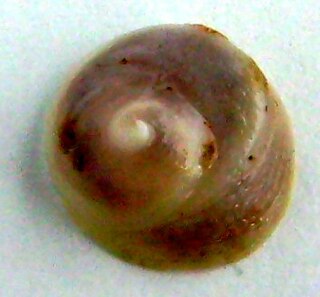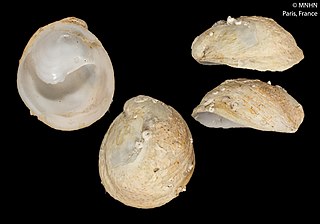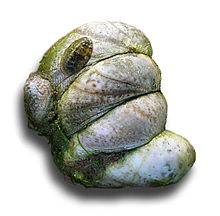
The Calyptraeidae are a family of small to medium-sized marine prosobranch gastropods.

Crepidula, commonly known as the slipper snails, slipper limpets, or slipper shells, is a genus of sea snails, marine gastropod mollusks in the family Calyptraeidae. This family includes the slipper snails (Crepidula), hat snails (Calyptraea), spiny slipper snails (Bostrycapulus), and cup-and-saucer snails (Crucibulum) as well as Crepipatella, Siphopatella, Grandicrepidula, and Maoricrypta.

Crepipatella is a genus of sea snails, marine gastropod mollusks in the family Calyptraeidae, the slipper snails and cup-and-saucer snails.

Crepidula adunca, common name the "hooked slippersnail" is a species of sea snail or "slipper snail", a marine gastropod mollusk in the family Calyptraeidae, the slipper snails and cup-and-saucer snails.

Calyptraea chinensis, common name the Chinese hat snail or Chinese hat shell, is a species of small sea snail, a marine gastropod mollusk in the family Calyptraeidae, the slipper snails or slipper limpets, cup-and-saucer snails, and Chinese hat snails.
Crepidula atrasolea is a species of small sea snail, a slipper snail, a marine gastropod mollusk in the family Calyptraeidae, the slipper snails or slipper limpets, cup-and-saucer snails, and hat snails.
Crepidula badisparsa is a species of sea snail, a marine gastropod mollusk in the family Calyptraeidae, the slipper snails or slipper limpets, cup-and-saucer snails, and Chinese hat snails.
Crepidula cachimilla is a species of sea snail, a marine gastropod mollusk in the family Calyptraeidae, the slipper snails or slipper limpets, cup-and-saucer snails, and Chinese hat snails.
Crepidula carioca is a species of sea snail, a marine gastropod mollusc in the family Calyptraeidae, the slipper snails or slipper limpets, cup-and-saucer snails, and Chinese hat snails.

Crepidula convexa is a species of sea snail, a marine gastropod mollusk in the family Calyptraeidae, the slipper snails or slipper limpets, cup-and-saucer snails, and Chinese hat snails. The maximum recorded shell length is 20 mm.
Crepidula depressa is a species of sea snail, a marine gastropod mollusk in the family Calyptraeidae, the slipper snails or slipper limpets, cup-and-saucer snails, and hat snails.
Crepidula intratesta is a species of sea snail, a marine gastropod mollusc in the family Calyptraeidae, the slipper snails or slipper limpets, cup-and-saucer snails, and Chinese hat snails.

Crepidula maculosa is a species of sea snail, a marine gastropod mollusk in the family Calyptraeidae, the slipper snails or slipper limpets, cup-and-saucer snails, and Chinese hat snails.
Crepidula margarita is a species of sea snail, a marine gastropod mollusc in the family Calyptraeidae, the slipper snails or slipper limpets, cup-and-saucer snails, and Chinese hat snails.

Crepidula moulinsii is a species of sea snail, a marine gastropod mollusk in the family Calyptraeidae, the slipper snails or slipper limpets, cup-and-saucer snails, and Chinese pant snails.

Crepidula plana, common name the eastern white slippersnail, is a species of sea snail, a marine gastropod mollusk in the family Calyptraeidae, the slipper snails or slipper limpets, cup-and-saucer snails, and hat snails. This species is characterized by a flat white shell, a white body, and development that includes a planktotrophic larval stage. This species often occurs inside large gastropod shells that are inhabited by hermit crabs. In this case the shells are often extremely flat, and often recurved.

Crepidula porcellana, common name the slipper limpet, is a species of sea snail, a marine gastropod mollusk in the family Calyptraeidae, the slipper snails or slipper limpets, cup-and-saucer snails, and Chinese hat snails.
Crepidula ustulatulina is a species of small sea snail, a slipper snail, a marine gastropod mollusk in the family Calyptraeidae, the slipper snails or slipper limpets, cup-and-saucer snails, and Chinese hat snails.

Siphopatella walshi, common name : the eastern white slipper limpet, is a species of small sea snail, a slipper snail, a marine gastropod mollusk in the family Calyptraeidae, the slipper snails or slipper limpets, cup-and-saucer snails, and Chinese hat snails.
















